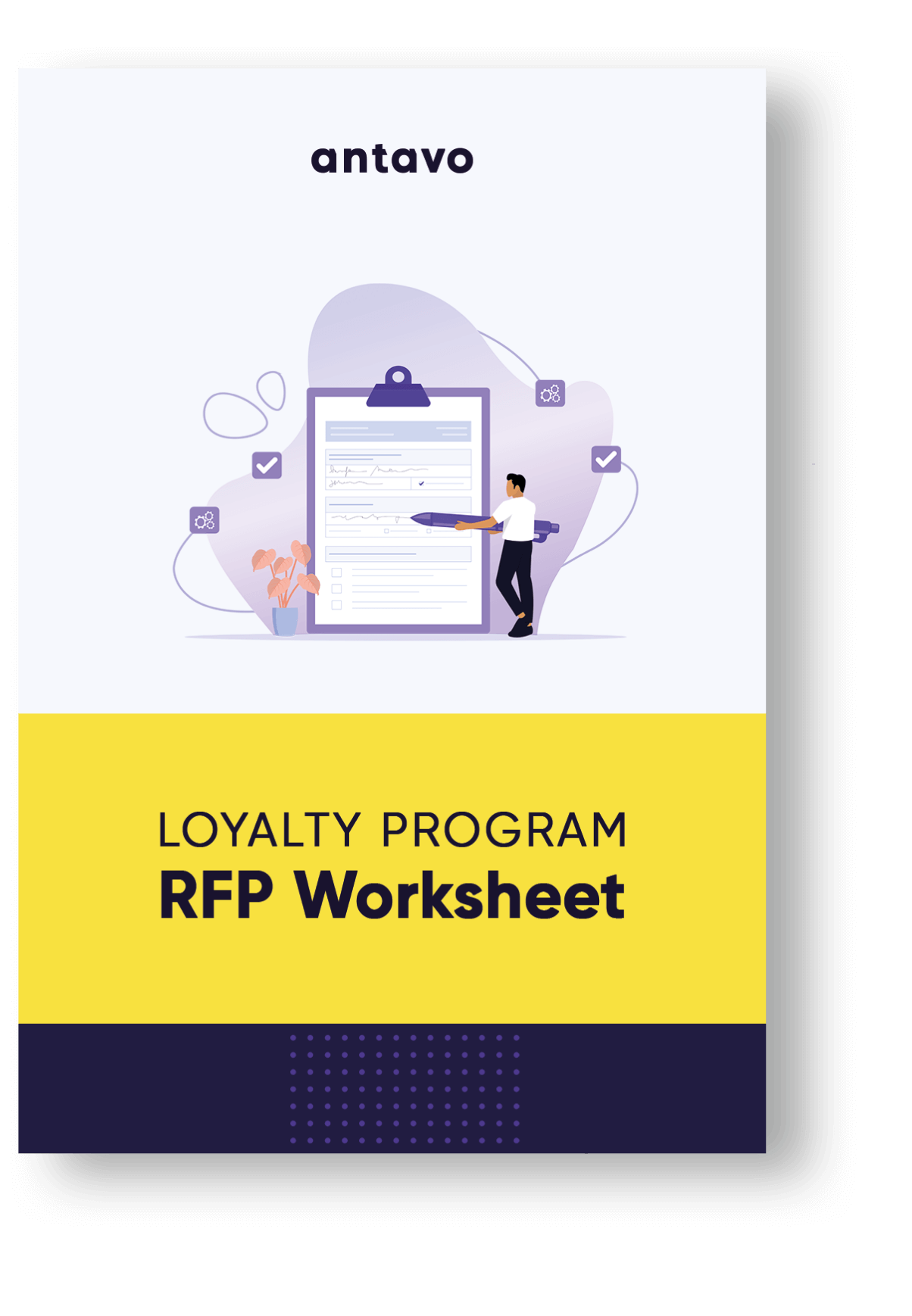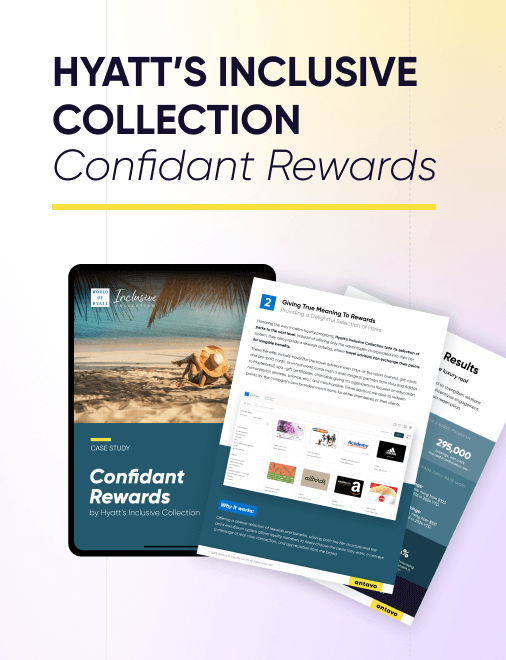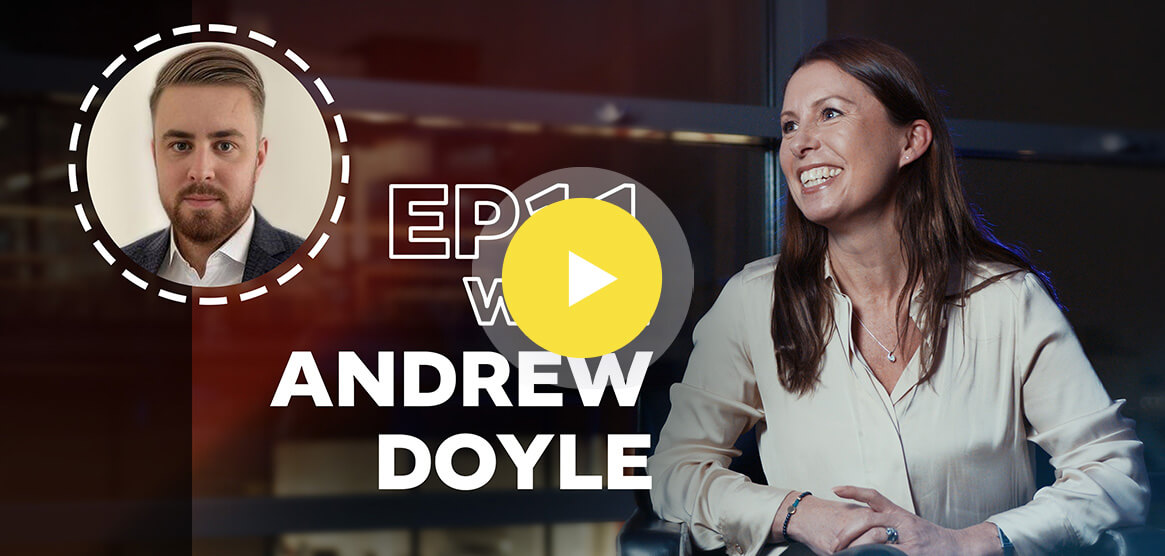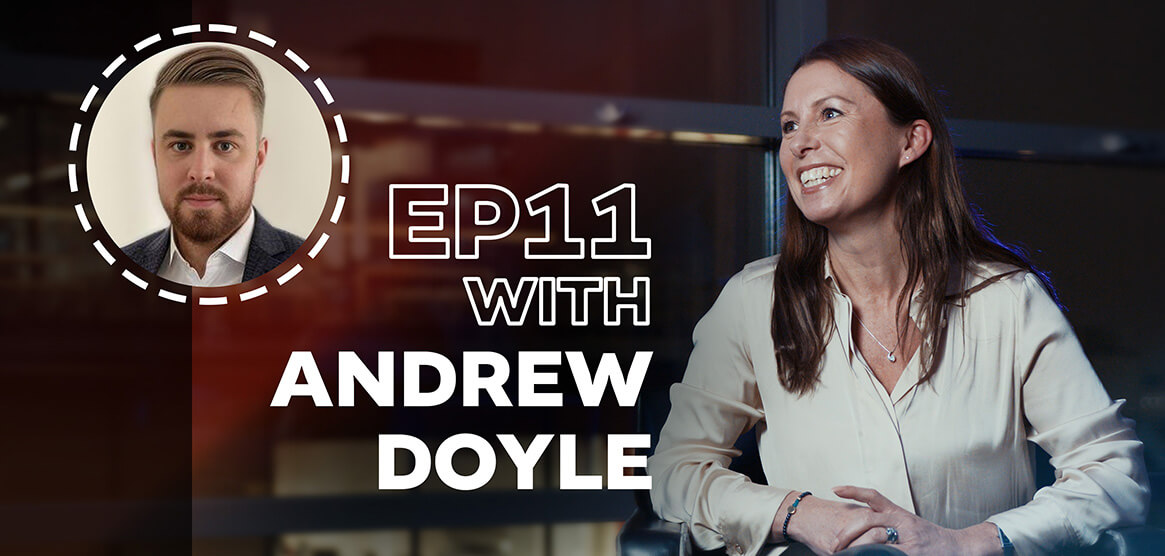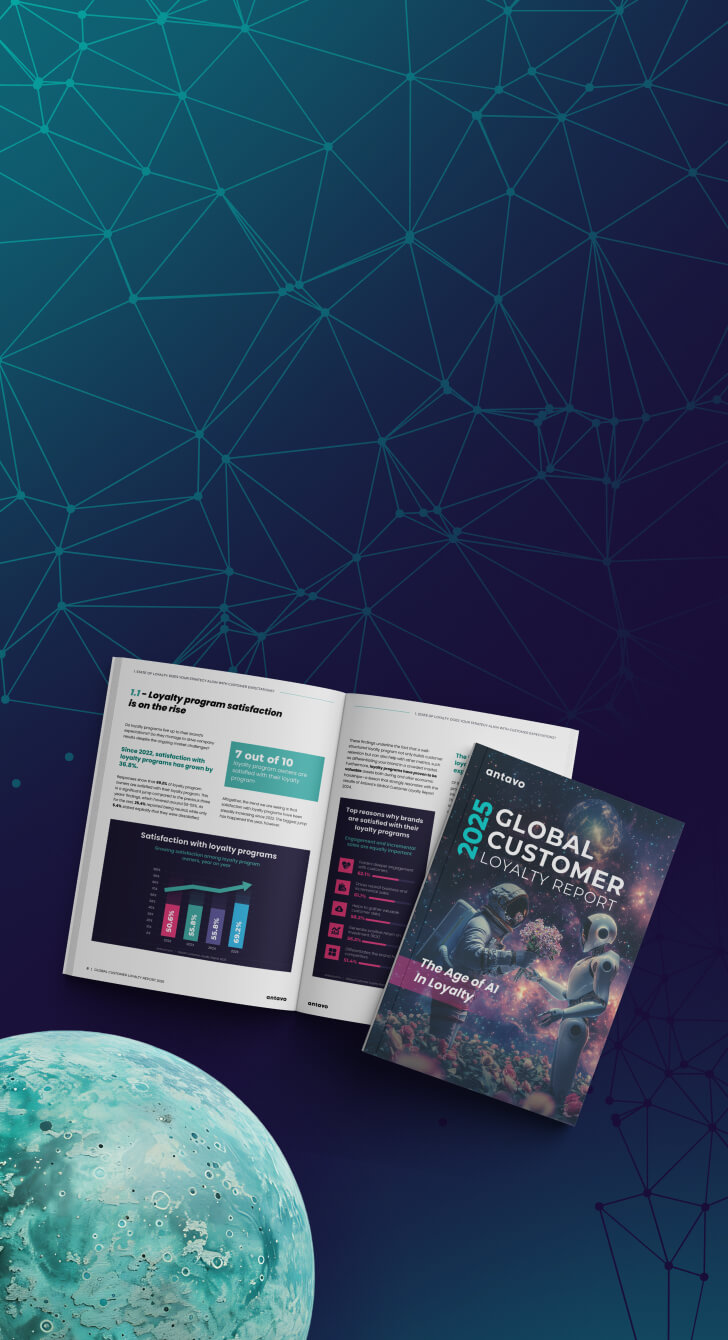On the eleventh episode of the Loyalty Stories podcast, we are joined by Andrew Doyle, Managing Principal & Practice Head at EPAM Continuum.
The interview for this podcast has been a valuable source for Antavo’s Global Customer Loyalty Report 2024. Make sure to download it for over 30 statistics on loyalty program trends.
This week, with Andrew’s help, we truly deep dive into the current state of loyalty programs, what recent changes led us here, and what key elements companies should really focus on to take their propositions to the next level. Andrew named Temu’s fun-filled program as a favorite and told us all about the incredible success of his own project: Asda Rewards. He also explained why innovation and purposeful partnerships are essential in the loyalty sphere now.
Highlights from our conversation with Andrew:
- What loyalty is like, standing on its own two feet at last
- How complex loyalty programs are subdivided into clubs and mini-programs
- Why headless and codeless loyalty systems are in high demand
- What you should expect when getting into the loyalty industry
Learn more:
- LinkedIn profile of Andrew Doyle
- The EPAM Continuum website
- See what Andrew thinks about Fuel Retail Loyalty Programs
- Book a demo with Antavo’s loyalty experts
Michelle
Hi everyone, welcome to Antavo Loyalty Stories. I’m Michelle Ellicott-Taylor, Head of Global Partnerships at Antavo. We’re a technology that powers loyalty programs all over the world, and we help great businesses such as KFC, Benefit Cosmetics, and many others. We’re running this podcast series at the moment, Loyalty Stories, to dive into trends in customer loyalty and get to speak to key experts in this area. So today’s expert is Andrew Doyle from EPAM. Andrew, welcome to the program.
Andrew
Hi Michelle, thank you, happy to be here.
Michelle
Hi, yeah I’m so pleased you are. I’m really looking forward to sharing the session with you today and finding out what insights that you can share with us around loyalty. But before we get into that, maybe you’d like to just tell everyone a bit more about yourself and about EPAM.
Andrew
Sure, so I’m a Managing Principal at EPAM. EPAM is one of the foremost professional services firms in digital transformation. EPAM Continuum is our integrated consulting business that brings together strategic business consulting with consumer innovation and experience consulting and technology consulting. And then connected to EPAM at large, we’re able to deliver the digital products, platforms and experiences that can bring to life things like multi-programs.
At EPAM, I head up our loyalty consulting team, and we focus on helping clients deliver next generation loyalty propositions, membership business models, subscription propositions, and the like.
Michelle
Wow, that sounds very interesting. There’s gonna be a lot that you can share with us today. That’s great. So thank you very much for that. And I think based on hearing what you’ve just said, we’d all be really keen to hear and it’s a great way to get started. What’s your favorite loyalty program? And can you tell us, sorry, who and why?
Andrew
Yeah, so I mean, I’m a big traveler, so I’m naturally bought into my kind of hotel and airline loyalty programs, but those are probably kind of the usual suspects that you hear a lot about. So perhaps a favorite one that I’m having a lot of conversations about at the moment is Temu. So Temu is a new marketplace shopping app. And within Temu, you can play games.
So you can play a game called Fishland and you can play a game called Farmland. And the aim of the game is to win a free product. So you can select a free product, clothing, household item, anything that you choose from the marketplace store. And the way you play the game is you feed your fish or you feed your farm animals. And to get the food to do that, you can gameplay. So you can log in and complete the tasks and so on forth within the game, but you get more food if you shop and you get more food if you refer friends.
And so really it’s a loyalty program. So it rewards you for your engagement, it rewards you when you make a purchase, it’s got member get member incentives in there, it’s a loyalty program in everything but name.
What I think is interesting is the way that it’s generating a loyal fan base, it’s got loyalty mechanics in there, it’s e-commerce, it’s wrapped in kind of everything that’s good about gamification. And so as I say, it’s kind of one I’m having a lot of conversations about. It will be interesting to watch what happens when they pivot out of growth mode and they start to think about kind of retention and activity levels. What kind of models they’ll, they’ll follow.
Michelle
That’s really interesting. I haven’t heard about this one before, so it’s really good to hear something that’s completely new. And the gamification part of that as well. And like you say, obviously it’s creating that loyal base. So that’s for us to go and have a look at then. And then what about with all the experience you’ve got? What about one that you’ve worked on yourself, whether that’s in your existing role or a previous role in loyalty? What would you say is your favourite project that you’ve worked on?
Andrew
Everything has its favorite moments for sure, but the one that takes the top spot for me is the delivery of Asda Rewards. It’s just a phenomenal success story when you think about customer outcome, the way customers love it, the way customers have adopted, and the value that customers are getting, and it’s also been fantastic in terms of business results.
It’s also a favourite because it’s kind of one of those once in a generation opportunities to bring to life a loyalty proposition in an industry that has been at it for a long time. So competitors have had loyalty programmes for kind of two decades or more. There was lots of chat around what was loyalty going to look like for Asda, a business that sort of traditionally said it wasn’t going to do it, decided it was going to do it, how was it going to do it, how was it going to look, and how successful was it going to be?
So it was a real privilege for my team and I to be involved and to tackle everything from those early questions around what loyalty would look like, what the right model was, how we should proceed through to standing in stores when it was launched and helping to run it for the first six months as the team was embedded. I think some of the elements that I’m most proud of are just the tremendous amounts of innovation within the proposition.
So the proposition doesn’t have a linear base earn, which is very different to the traditional model in the industry. And I think it’s perhaps the largest program in a transactional based industry to not have a base earn and certainly to do well from not having a base earn. And I think we can also be very proud of the timeline in which it was delivered, not only to take the proposition to market, but also everything else that sits around it.
So this is a business did not have some of the foundational elements that would not only support a loyalty program but extract the best value from a loyalty program. That all had to be put in place to kind of bring the organization along a journey towards data-driven modern retailing and to do all of that and see all of the great results, how could I not be proud?
Michelle
Yeah, that’s amazing. And something like that where you’ve been, I guess, in the very early stages of ideas and then watching something like that come to fruition and how it’s continuing to evolve.
Andrew
Yeah. And it’s quite unique actually, to see how much of the original concept actually made it to market. You know, quite a lot of the time, there can be some great innovative ideas, but what comes to market looks a little bit more normal. You know, there’s a bit of kind of playing it safe.
One of the things, which all of the leaders involved should take credit in, I think is, is being brave in carrying forwards the innovation and not following the sector and by being brave and doing something different they’ve not only seen great results but they’ve also got a great foundation to continue to prosper.
Michelle
Oh, that’s a big compliment to the team there. That’s great to hear. And actually, another partner that I was speaking to, a loyalty consultant was talking about, it’s really important for people to have backbone to be different. And like you’re saying, be innovative and don’t just go with what was always the practice version and, you know, reach rewards at the time, but times change and you need to look at it.
So you got to be brave to move forward with that. So, on that note, just thinking about your experience in this space. What would you say are like the significant changes that you’ve seen in the last couple of years?
Andrew
So I think there are three. The first would be around who’s interested in the loyalty agenda. And what I have seen very distinctly over the last couple of years is that this has become a bored topic. So, you know, this is no longer buried somewhere deep down within a customer function, where it’s someone’s job to worry about the loyalty program.
And loyalty has started to shake, I think, certainly in more mature and forward thinking organisations, it has started to shake its reputation as that CRM thing or that promo and trading thing. And the board are starting to see the value that it can bring to the organisation and the way it can be a growth driver, which I think is fantastic.
The second is around what’s out there. And I think if you look in aggregate at the loyalty programs and propositions which are in the market. They’re certainly more complex than they ever were. I think there’s ever increasing complexity and that’s not necessarily a bad thing. I think design practice can sometimes tell you that simplicity is best. But actually when you think about the complexity that’s come into recent loyalty programs and propositions, yes, they are more involved.
There’s more mental involvement that’s required from a consumer, but the payoff is much bigger than it has been historically. And I think if you do sometimes opt for simplicity, you end up with a lot of passive behaviours, you can’t put much money behind that for obvious reasons, and therefore consumers become bored with it and you kind of end up in this spiral of decline. So this era of more complex, more involved, but more valuable programmes, I think is likely to continue.
And then the third change that I’ve seen is more in how programs are being executed. And I think we’re seeing the resurgence of partnerships. I think, you know, the saying that everything goes in cycles, I think this is one of those things. I think they’re back. A decade or more ago, it was an incredibly popular thing to do and you had the large partnership programs and coalition programs and so on. I think we’re starting to see the resurgence of partners in a more targeted way.
I don’t think a coalition in a traditional sense is necessarily back, but we are starting to see purposeful partnerships where the two brands uniquely have something to offer and they can uniquely serve a customer need. And there’s a mutually beneficial relationship in terms of capturing a greater share of wallet between the two organizations. And so we’re starting to see some of those partnerships come back and I think more organisations will be thinking quite hard about partnerships and whether it’s right for them.
Michelle
Yeah, I think there’s been, like you say, a big resurgence in that. And some people I’ve been speaking with have been talking about those kind of, I guess, collaborations between sponsorships with say retailers and football clubs, things like that, and how they can win together with that wider view on the end customers. So, yeah, it’s going to be interesting to watch that.
You’re kind of moving into where I wanted to question you next around the trends that are coming. So those are really great examples of changes that you’ve seen, and do you see on in addition to those because those are fantastic but anything else is like maybe two key trends that are coming over the next I don’t know 12-24 months?
Andrew
Yeah, so if I was to be drawn on what I think was going to come next, I think perhaps building on my point around the increasing complexity, I think we will start to see more mini-programmes, sub-programmes, some people might call them clubs within loyalty programmes. So I think starting to break down a larger and perhaps more complex program into some more discrete units that allows you to just better communicate the features and benefits to smaller groups of customers.
So you know, focus on a particular customer need, a particular customer mission, a particular customer segment, for example. And the benefit of that obviously is that they all sit within the main program because needs and missions can change over time. So you are essentially then sort of migrating people from one module to another or one area of focus to another. And I think we have started to see more clubs and the like pop up. My prediction would be that we start to see more of that.
And as we go through the kind of natural reinvention cycles of some of the larger programmes, I think people will be starting to think about ways that they could subdivide the overall programme to help them better structure the features and benefits and help consumers understand what they can be accessing at any one time.
Michelle
Yeah, that’s really interesting just thinking about, I mean, you’ve got the idea of clubs there where you’ve got, say, exclusivity, like with a VIP Club. But then there’s also, I don’t know, within a brand, there are different segments, not just about VIP, but people’s interests. And, you know, it’s still one loyalty program, but creating those segments within it. So and that links back into the personalization as well, doesn’t it?
Andrew
Yeah, exactly. I mean, often there’s a huge portfolio of features and benefits. And, you know, one of the challenges is you can’t talk about them all at the same time and personalization would drive you to talk about the right ones to the right people at the right time. But more so than that, I think with the increasing complexity, starting to package or compartmentalize them into sort of sub programs just allows you to execute on that in a in a better way, but you clearly still keep the overall base and you allow people to move from one to the other, as I say.
Michelle
Yeah, yeah, great. Okay. And thinking about that with when you’re thinking about the platforms that can obviously support with their capabilities on these different loyalty strategies, what do you see, I guess, as maybe consultants that you’re looking for in a platform to make sure it’s robust and is going to be not just what it’s doing now, but what it’s doing in 12 months, 24 months, you know, the openness of the roadmap, things like that, but also from the customer perspective.
So I guess our people, you know, are you looking at things like: Is it the integration? Is it implementation? Is it ease of use? Is it off the shelf? Is it the gamification omni-channel? I mean there’s so many things, but yeah, what do you see that’s kind of front of mind when you’re looking at these things?
Andrew
I think there are a couple of things which are kind of the givens or the hygiene factors to even be in consideration when you’re kind of evaluating your platform needs. Ease of implementation, integration, they’re all important. No one wants to take on a complex implementation. People want to make sure that integrations are in place, organizations treat the various stages of the digital transformations have made large and strategic investments in multiple platforms in and around the customer space.
So whether that’s e-commerce, whether that’s around CRM, for example, they always want to see that the next investment that they’re making and if that next investment is in launching a loyalty program or replatforming their loyalty program, they want to see that it’s complementary. They want to see that it’s going to work with what they’ve already put in place. They’ve invested time, money, corporate focus in making that work. They want things to be complimentary.
They will also want to, if they’re a forward thinking organization, see the multiplier effect across multiple business cases. So you’ve got a really great business case for loyalty, but I understand where it is gonna add a multiplier to my e-commerce business case, for example. So those are kind of almost the givens.
Then I think you know, bringing innovation and continuous innovation within the platform is important. You almost want to have more in the platform than you’re planning to launch in your program, because you have to have a really good roadmap in terms of where you want to go. And consciously, when I’m working with clients, one of my principles, the building a roadmap is, you know, deliberately hold some good stuff back because you want to have a pipeline of new news that you can talk to people about it.
It’s helpful in terms of keeping up the interest levels and keeping up your activity levels and so on. And so having things within a product that you can quite easily turn on becomes really helpful.
And then I think the other thing that is a hallmark of a good loyalty platform is just working quietly in the background. And so, you know, being headless, you can connect it into wherever you want to surface loyalty across the organization and you deliberately want to surface it in all of your comms, all of your apps, your e-commerce site and retail stores.
And being codeless for the business as well. So allowing a loyalty team to run and operate without everything having to be a project. You don’t want to have to start briefing into IT teams that you need to make X, Y, and Z changes to adapt a proposition.
You want to be able to configure things yourself because you want to be able to do things quickly, identify an opportunity and be able to execute on it and be able to learn so that you’re sort of operating your test and learn cycles within your proposition within the control of your business as well without being reliant on like I say an IT team or a third party organisation.
Michelle
I think as well when you’re talking with these customers or the brands, they aren’t looking at something that’s just going to tick a box for six to 12 months, are they? It’s a longer term view. Like you said, the board are interested in loyalty now, so they need to know. I like your point that you can start with something smaller, but the platform has all the capabilities there. They just don’t need all of that yet, but they can evolve with that.
Andrew
Yeah.
Michelle
Yeah, excellent. Okay. And just thinking about EPAM and how the size of your organisation on a global perspective, do you see, do you get insights on differences regionally with loyalty programs, or there’s commonalities?
Andrew
I mean, regional differences can be more pronounced than people might think. You know, you can, the first lens to look at it is probably the regions where loyalty is older and perhaps a little more mature. So some of the places where it grew up first.
But then the second lens to apply is the drivers of other factors and other influences. And I’ll give you a couple of examples. So if you think about the US and the UK, they’re both relatively established loyalty markets. Some of the original programs grew up in those markets, but actually if you were to compare the two, the UK is probably more mature and more innovative.
It’s further forward than the US. If you were to compare different loyalty models, the US is probably still more traditional versus the UK which is a little further forward in terms of digital and so forth.
But then that doesn’t necessarily hold true across Europe as a region. So again, the UK is very different to Germany, for example, and that’s because in the UK we’re further ahead in areas like payment. So if you think about the adoption of contactless payment that has driven the convergence of loyalty and payments in this particular market Germany isn’t there yet because Germany doesn’t have the same level of adoption around contactless payments and mobile payment wallets and so on.
Quite a lot of the economy still runs on cash. And so loyalty programs haven’t evolved in the same way. And you have to take that into account if you are a global organization. Often the solution that you end up going for is you have the single program framework that operates on a single technology solution with a single operating model that sits around it, but you’re able to customize what the program looks like in a particular market.
And you want to do that because everyone wants to strive for innovation. Everyone wants to go for new opportunities, but you have to make sure it’s still relevant to the market that you’re launching in. So you would want to be differentiated and innovative in terms of being one step ahead of your competitors, but you don’t want to be two or three steps ahead of the consumer.
Michelle
Yes. And I think as well, you’re bearing in mind that a brand who’s operating on a global basis, they’ve got to be conscious that just something that’s working for them in the UK isn’t necessarily going to work in APAC. They’ve got to see what that market is responding to. Yeah.
Okay. And with the, I guess, the huge amount of opportunities that EPAM as a global business work with, where are you seeing that the assignments from a loyalty team’s perspective are coming from? So is it, so you mentioned the board level, much of that couple of times.
So, are there more senior people involved? Are you still seeing it’s coming from say the CMO or the head of loyalty? Is there a mix? It’s interesting to get a picture.
Andrew
Yeah, so as I say, it is a board topic. But then if you to look at well, where in the board is the brief coming from to your question? So is it still coming from the CMO? In the more mature organisations, it will come from the CMO, because that is where loyalty has traditionally kind of grown up. And it’s still where it sits.
In some organisations, they’re starting to learn that everyone should really own loyalty. And perhaps there’s a bit of a debate about who should own it. In the same way that traditionally you’ve kind of seen that debate around the e-commerce, it sort of grew up as a function on its own. And then people started to realise what actually are trading and our marketing, for example, should be common across e-commerce and retail. So the vast majority of the BCS are coming from the CMO. Sure, they’re also coming from heads of digital.
Heads of digital and chief digital officers can be a bit of a variable role. Some can be a bit more on the business side. Some can be a bit more on the technology side. In those that have a bit more of a business leaning, you can have a digital function that would own loyalty as it would own some of the other digital services. So, you know, things like pre-order and the types of things that you see in quick serve restaurants and those types of businesses that would tend to have a digital function, but actually a number of the conversations that I have can also be with other board seats.
So like the CFO, for example, particularly in some of the larger organizations that have had loyalty for a long time. The reason that a brief evolves is because it’s a question that’s crossing the CFO’s mind around kind of the return on investment. So they’ve had a program for a long time. It’s a significant item in the P&L.
They’re looking for some guidance on whether the shape of the P&L looks right, do the costs look right? Are they evaluating the benefit in the correct way? And that can then drive back into a brief around, well, how would we optimize or reinvent our program?
And so I think it is still predominantly coming from the CMO. It can come from other board seats. I think the, you know, the factor that determines that is where is the organization and what’s it trying to achieve at that particular point in time?
Michelle
Yeah, like you say, the size of it, the maturity of the business, but the point about CFO, that’s been quite common actually, that they are getting more involved because they are assessing the existing programmes and looking at that ROI basically. So they’re getting closer to the decision making on the implementation on these kind of campaigns. So great. Okay.
And then I wanted to ask you some advice really for people out there who are getting started in loyalty. So after you’ve mentioned all of those decision-makers there. So someone’s maybe just starting out, you know, graduate, they’re going in a junior role in a loyalty management team and they’re aspiring to be, you know, the director of that team. What do you think someone needs to be, you know, in that space needs to be thinking about in regards to how they’re going to grow and progress in loyalty and how they’re working with the customer base?
Andrew
Yeah, I think my biggest piece of advice would be learned to speak two languages, learn to speak the language of brand and learn to speak the language of commercial because you know, wherever that person sits, they’ll they will report through a customer or a brand function or more of a commercial or a trading function, but they need to speak both languages and actually the most successful people are the people who connect the two together.
They’re the people who can get the two to see a joint opportunity in a proposal that’s being put forward. Particularly if you want to do something bold like launch a loyalty program or reinvent a loyalty program. As we’ve said, everyone needs to be on the same page. Everyone needs to sponsor it in the same way.
And if you want to grow into the more senior roles, you’re gonna have stakeholders from those two sides of the house, being able to empathize with, their particular point of view, understanding their objectives and understanding how the two come together towards the success of the organisation, I think is a key skill.
Michelle
Oh, that’s great. Thanks for sharing that. I’m sure there’ll be many people watching this thinking that, you know, that’s some really good advice. So thank you for that. And we’ve nearly got to wrap up. But just before we do, I was just going to ask you, I know you’ve already mentioned like what’s been your favourite, yeah, loyalty programme, but is there something, I guess, in the recent times in the last six to 12 months that surprised you with loyalty? Maybe where someone’s done something slightly different?
Andrew
I tell you something that probably, I am surprised by, I watch. And that is the continued shift towards revenue-based programs. So I’m thinking particularly about airlines and hotels. And you can absolutely see the logic as to why.
Basic spreadsheet analysis will show you the benefit of moving towards a revenue-based program. But the reason that I am surprised to see so many moves towards it is because I’m yet to fully understand quite how an organization is mitigating the risk that comes with that.
So if you take those programs, they are by their nature, very transactional programs. But at the same time, they’re quite emotive because you’re taking that extra holiday or you’re upgrading to a suite when you would have otherwise been in a standard room. In sort of the former program structure you used to be able to look at what that was going to be, you looked up an award chart and you sort of mentally were able to work towards it.
In a revenue-based model it’s variable, it’s linked to the cash price, you can’t really do that because you don’t know what it’s going to cost you until the point at which you’re going to book it. It feels very transactional. So you’ve suddenly lost the aspirational element that worked so well in those programs. And actually, you know, the best place to be is probably somewhere in the middle, you get a bit of your devaluation by moving to a revenue model, but within some thresholds, so that you kind of keep a bit of the old structure alive.
Lots of people are making those moves. You know, there will always be people who are unhappy about them for I think people in the industry who are kind of observing where those moves are going and then how other people react to those moves and how it informs the strategies that the next organization takes. It would be interesting to see whether that trend continues or whether people kind of craft out a slightly different path and a slightly different take on what is a trend to move towards revenue-based programs.
Michelle
Yeah, okay. Well, that’s great. Well, thank you. Thanks so much for everything content wise you’ve shared today. It’s been great. And I did want to highlight the fact that you’re one of the headline key partners associated with our global loyalty report. So we really appreciate all your time and effort in this. And we’re looking forward to making a lot of noise about the loyalty subject alongside EPAM. So yeah, thank you very much.
Andrew
No, super. It’s a really, really valuable piece of research. I think what comes out of it is so valuable and, you know, it empowers everyone who has a copy of the report. So I think we’re all equally looking forward to seeing what the results are of this year’s study.
Michelle
Yeah, yeah, definitely. That’s great. Thank you very much. And thank you to everyone for watching Loyalty Stories. Wherever you see this or listen to this, please give us a like.
And yeah, please don’t hesitate to reach out to Andrew Doyle at EPAM if you’ve got any queries around loyalty strategy. And of course, visit us at antavo.com for any questions about your loyalty platform and how you want to move forward with that. And thank you for your time.
